|
Shiny Cowbird Molothrus bonariensis Tordo Lustroso, Vaquero Brilloso
|
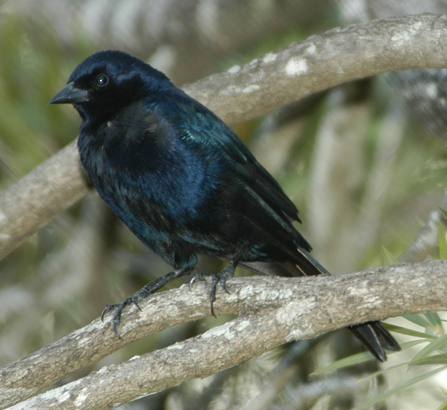 |
|
Adult male - Photo: G. Beaton
|
|
Shiny Cowbird Molothrus bonariensis Tordo Lustroso, Vaquero Brilloso
|
 |
|
Adult male - Photo: G. Beaton
|
|
IDENTIFICATION: The Shiny Cowbird has a stout, pointed bill. Males are a shiny purple-black color, while females are a dull, dark gray. In flight the cowbird appears smaller and more slender than the Greater Antillean Grackle. Length: 18-20 cm.; weight: males 40 g., females 34 g. VOICE: The male’s song is a series of bubbly notes followed by a whistle. Audio 4 (M. Oberle). The bird fluffs up the feathers around its neck as it utters these notes, and often sings while flying. The female has a brief, bubbly "chatter" call. Both sexes make a high-pitched, whistled contact note. HABITAT: Prefers open or brushy fields, often near livestock, but can be found in open forests, or suburban gardens as well. HABITS: As its name suggests, the Shiny Cowbird does feed near cattle, but can forage in any open field for grain, seeds and insects. The Cowbird travels in flocks either with its own species or in the company of Greater Antillean Grackles or Yellow-shouldered Blackbirds. The cowbird spends the night in a communal roost. It does not build a nest of its own, but parasitizes other birds' nests. Nest parasitism harms the host bird in a number of ways. Sometimes the female cowbird ejects the host’s eggs. The nest's builder will sometimes abandon the nest if it recognizes the alien cowbird egg, or sometimes will build another nest layer on top of the original nest, thus killing both its own clutch and the cowbird egg. Often the cowbird chick grows more rapidly than the chicks of the nest's builder and and deprives them of food resources. Throughout its range in the Americas, the Shiny Cowbird has been documented to parasitize the nests of over 201 species of other birds, including Yellow Warbler, Yellow-shouldered Blackbird, Greater Antillean Oriole, and Black-whiskered Vireo. STATUS AND CONSERVATION: Originally native to South America. One sighting of the Shiny Cowbird was reported from Vieques in 1860 (possibly an escaped cage bird), but the species was not reported from the Antilles again until the 1890s. During the 20th Century, the species expanded its range from island to island, taking advantage of habitat changes due to agriculture and cattle ranching. The cowbird was documented to breed in Puerto Rico starting about 1955. The cowbird’s breeding behavior of parasitizing other birds' nests has reduced the nesting success of the endemic Puerto Rican Vireo and the endangered Yellow-shouldered Blackbird. A trapping program to remove cowbirds from the blackbird's breeding range in southwestern Puerto Rico is a key strategy to keep the blackbird from becoming extinct on the main island of Puerto Rico. RANGE: Now breeds from the southern tip of Florida (where it first arrived in the early 1980s), east through the Caribbean and northern South America to the lowlands of Chile and Argentina. It has even reached Yucatán, Mexico. It is found throughout Puerto Rico, especially in lowland agricultural areas. Stray Shiny Cowbirds have been found as far north as New Brunswick, Canada. TAXONOMY: PASSERIFORMES; ICTERIDAE. Formerly called Glossy Cowbird. |
 |
|
Immature and adult male - Photo: E. Ventosa*
|
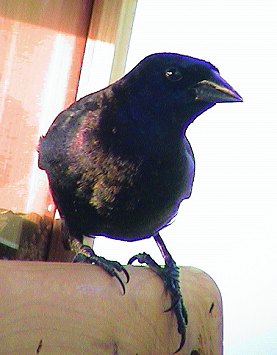 |
|
Male - Photo: R. Rodríguez Mojica
|
 |
|
Male - Photo: R. Rodríguez Mojica
|
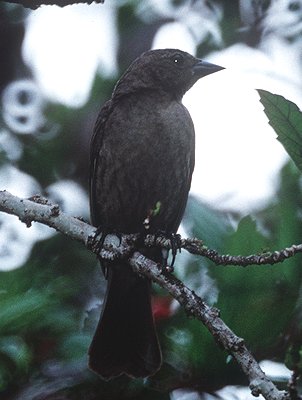 |
|
Female - Photo: M. Oberle
|
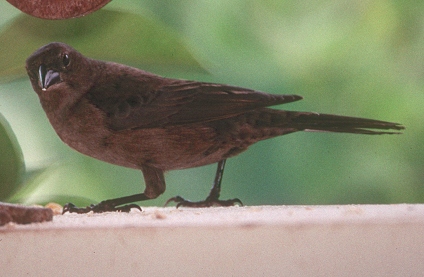 |
|
Female - Photo: M. Oberle
|
 |
|
Female - Photo: M. Oberle
|
 |
|
Female - Photo: M. Oberle
|
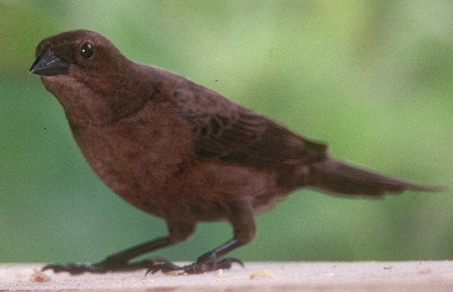 |
|
Female - Photo: M. Oberle
|
|
References Camacho Rodríguez, M., J. Chabert Llompart, and M. López Flores. 1999. Guía para la identificación de las aves exóticas establecidas en Puerto Rico. Depto. de Recursos Naturales y Ambientales, San Juan, PR. Grzybowski, J. A. and C. M. Pease. 1999. A model of the dynamics of cowbirds and their host communities. Auk 116(1):209-222. Grzybowski, J. A. and C. M. Pease. 1999. Cowbirds: villains or scapegoats. Birding 31:448-451. Jaramillo A. and P. Burke. 1999. New World Blackbirds: The Icterids. Princeton Univ Press. Kluza, D. A. 1998. First record of Shiny Cowbird (Molothrus bonariensis) in Yucatan, Mexico. Wilson Bull. 110:429-430. Lowther, P. and W. Post. 1999. Shiny Cowbird (Molothrus bonariensis). in The birds of North America, No. 399 (A. Poole and F. Gill, eds.). The Birds of North America, Inc., Philadelphia, PA. Norton, R. L. 1981. Additional records and notes of birds in the Virgin Islands. Am Birds 35:144-147. Orians, G. 1985. Blackbirds of the Americas. Univ. of Washington Press, Seattle, WA. Ortega, C. 1998. Cowbirds and other brood parasites. U Arizona, Tucson. Post, W. and J. W. Wiley. 1977. The shiny cowbird in the West Indies. Condor 79:119-121. Post, W., T.K. Nakamura, and A. Cruz. 1990. Patterns of shiny cowbird parasitism in St. Lucia and Southwestern Puerto Rico. Condor 92:461-469. Pérez-Rivera, R. A. 1986. Parasitism by the Shiny Cowbird in the interior parts of Puerto Rico. J Field Ornith. 57:99-104. Pranty, B. 2000. Shiny Cowbird: possible anywhere. Birding 32(6):514-526; correction, Birding. 2001. 33(1):10. Raffaele, H.A. 1989. A guide to the birds of Puerto Rico and the Virgin Islands. Princeton. Raffaele, H.A. 1989. Una guía a las aves de Puerto Rico y las Islas Vírgenes. Publishing Resources, Inc., Santurce, PR. Raffaele, H.A., J.W. Wiley, O.H. Garrido, A.R. Keith, and J.I. Raffaele. 1998. Guide to the birds of the West Indies. Princeton. Ridgely, R.S. and Tudor, G. 1989. The birds of South America: the oscine passerines. Univ. Texas Press, Austin. Wiley, J.W. 1985. Shiny Cowbird parasitism in two avian communities in Puerto Rico. Condor 87:165-176. Wiley, J.W. 1986. Growth of Shiny Cowbird and host chicks. Wilson Bull. 98:126-131. Woodworth, B.L. 1991. Impact of Shiny Cowbird parasitism on the reproductive success of the Puerto Rican Vireo in Guánica forest, Puerto Rico. El Pitirre. 4(3):9. Next related species in taxonomic order Previous related species in taxonomic order |